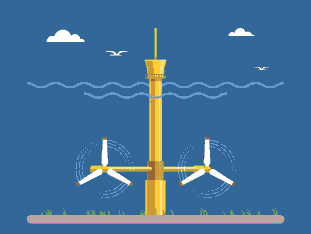The Kalpasar Project (Yojana) – Gujarat under the gulf of Khambhat development project is mainly a water resources project by way of building an Over the Sea dam across the Gulf of Khambhat. this is also called Kalpsar Yojana.
The objective of establish a huge freshwater reservoir to meet the demand for drinking, irrigation, and domestic and industrial water supply. and its supplementary objective as a benefit from the Kalpasar project is to reservoir use of the top of the dam across the gulf as a surface transport link, potential development of fisheries, reclamation of saline land, and project related to renewable energy.

If the Kalpasar project is complete then it will become the World’s Largest man-made freshwater reservoir in the Sea.
[toc]
The meaning of ‘Kalpasar’:
‘Kalpasar’ means a lake that fulfills all the wishes. The word originates from the Hindu mythological ‘Kalpa Vriksha’ – a wishing tree.
This grand scheme called Kalpasar was conceived and developed by utilizing the concepts of the two most successfully implemented projects in the world.
The Idea of Kalpasar Project:
It details the proposed 530 billionKalpasar multipurpose dam project which is envisaged for construction across theGulfofKhambhat.
By the Kalpasar project, a mega freshwater reservoir will be constructed on the upstream side of the dam by impounding the surplus waters of numerous rivers like Narmada, Dhadar, Mahi, Vatrak, Meshavo, Sabarmati, Bhogavo, Ghelo, and Kalubhar.
The Kalpsar Yojana, if this project is implemented with dedication and without corruption, will resolve four vital problems of the State of Gujarat which arewater, electrical power, road-rail transport, and development of ports.
The requirements of Kalpasar Project:
The western and south-western parts of Gujarat always remain uncertain about water availability for general purposes and irrigation in the area. Further, the groundwater around the coastal area, which extends almost 60-70 % of the periphery of the state found not suitable for farming and general use.
The efforts to make water available in this region have been made through the construction of dams on rivers available in that part of the state. however, which did not suffice the quantum of water requirement largely due to poor monsoon.
The state of Gujarat is one of the most advanced industrial states in the country, and the power requirement for nurturing these industries is also one of the major issues that need to be addressed to bring prosperity to the state. Presently supply of power is being met by thermal power plants which is much below the total electricity requirement of the state.
Objectives of Kalpasar Project:
In the Gulf of Khambhat, embraced by the Gujarat mainland and the eastern coast of the Saurashtra peninsula, yearly a volume of over 30,000 Mm3 of water flows away before it can be used to mitigate the severe shortage of drinking and irrigation water in Gujarat, especially in the Saurashtra peninsula.
The Gulf of Khambhat Project or Kalpasar Project aims at the creation of a freshwater reservoir in the Gulf of Khambhat through the construction of a dam connecting the east and west banks of the Gulf.
In the reservoir, the runoff from Sabarmati, Mahi, Dhadar, and Narmada will be stored, together with the waters from the Saurashtra rivers discharging into the Gulf of Khambhat. The stored waters are to be used for irrigation, water supply, and industrial requirements in the Saurashtra region.
The Kalpasar Project is considered the evident solution for solving the short as well as the long-term threatening drinking and irrigation water problems in Saurashtra.
Once the Gulf is closed, water levels within the reservoir can be controlled while the tidal fluctuation outside the reservoir continues and, hence, can be harnessed for the generation of tidal energy.
In addition to freshwater storage and tidal power generation, the Kalpasar Project also aims at land reclamation, transportation improvements, and fisheries development. The details proposed 530 billion Kalpasar multipurpose dam project which is envisaged for construction across the Gulf of Khambhat.
By the Kalpasar project, a mega freshwater reservoir will be constructed on the upstream side of the dam by impounding the surplus waters of numerous rivers.
The Kalpasar project, if implemented with dedication and without corruption, will resolve four vital problems of the State of Gujarat which are water, electrical power, road-rail transport, and the development of ports.
Technical Objectives of Kalpasar Project:

Gujarat is a water-deficient State. It occupies 6.4 % of the land area of the country and has 5% of the country’s human population, but its surface water resource is only 2% of the country.
The per capita per annum water availability is 990 cubic meters in the State which is much below the minimum requirement of 1700 cubic meters. Every year, 38000 million cubic meters of average surface water is available in the State. However, even after including the Sardar Sarovar Project (SSP), only 20480 million cubic meters (54%) are possible to store.
There is no suitable site of land in the State, available for the creation of a river valley project to store surplus / untapped above 40% surface water.
In such a circumstance, the Gulf of Khambhat is an eligible option to create a reservoir by construction of a Gulf closure dam which can store about 10,000 million cubic meters of water inflows from the rivers (Narmada, Dhadhar, Mahi, Sabarmati, and some of the Saurashtra rivers), which accounts for 25% of total surface water resources of Gujarat.
The creation of this freshwater reservoir does not involve any land acquisition or rehabilitation of people and will serve as a lifeline of the Saurashtra region as well as an accelerator for the growing economic activities of Gujarat State.
The Gulf of Khambhat extends from north to south about 200 km and the width varies from 25 km at the inner end to 150 km at the outer mouth, covering an area of 17000 sq. km, of which only 2000 sq. km will be enclosed by constructing a dam across the Gulf between Bhavnagar and Dahej.
Benefits of Kalpasar Yojana:

- If The Kalpasar Project is completed then it will become the World’s largest man-made freshwater reservoir in the sea.
- Highest importance and priority to irrigation and drinking water for Saurashtra and Central Gujarat regions.
- The Reservoir will have storage of more than double the Sardar Sarovar (Narmada Reservoir) capacity.
- More than 10.54 lakh ha of land in 39 talukas of 6 districts of Saurashtra region will get irrigation benefit facilities including rejuvenation of rivers. More than 60 existing dams will be permanently filled up with water.
- The Wind and solar energy will be generated which can also be used for lifting fresh water from the reservoir to the canal.
- Bhavnagar port will get revived which will result in speedy development of the region Because of The Kalpasar Project
- There will be large savings in travel time and fuel due to the reduction in the distance by about 200 km between Bhavnagar to Surat-Mumbai.
- The saline groundwater of the coastal area of Saurashtra & Central Gujarat will be converted into fresh water with a reduction in soil salinity.
- Substantial improvement in groundwater quality as well as soil salinity of the coastal area of Saurashtra & Central Gujarat.
- About 2 lakh ha of land along the periphery of the reservoir will be opened up for development towards value-based land utilization.
- The enhanced benefit of world-class industrial estates like Dahej and Dholera will be available to the Bhavnagar/Saurashtra region.
The Kalpsar Yojana Benefitin details:
Water supply for domestic use:

Studies have opined that the population growth would reach a zero level by the year 2055 and the population projection for that year amounts to 36 million inhabitants in water deficit areas of the State.
Considering this the domestic and industrial water demand for the year 2055 has been estimated at 7,407 MLD or 2,700 million m3per year.
It is planned that the Kalpasar freshwater reservoir will provide 900 million m3 for domestic use.
Irrigation from freshwater reservoir:

After the implementation of the Kalpasar Project, the freshwater reservoir volume between levels -5 m Mean Sea Level to +5 m Mean Sea Level would be available.
This volume has been reassessed in recent detailed studies at 12,248 million m3, which is practically equal to the average yearly inflows of surplus waters from the rivers falling in theGulfofKhambhat.
5,891 million meter cube of freshwater will be available for irrigation.
With the available 5,461 million m3of water, it is possible to irrigate some 1,054,500 hectares net.
10.54 lakh hectares of land is going to irrigate and about 1,19,000 hectares of saline land is also cultivated.
Water supply for industrial use:

For industrialization, water becomes one of the most important resources, particularly in water-scarce areas such as North Gujarat, East Gujarat, and Kachchh, where other resources such as land, manpower, etc. are also available in abundance.
500 million meter cube is provided for in the freshwater lake of Kalpasar for industrial use in the water-scarce areas.
Tidal Power:

The demand for energy inGujarathas been growing due to increasing industrial and agricultural activities. Kalpasar, therefore, would provide a renewable and environmentally sustainable power source inGujaratthat would spearhead the economic growth in the whole of the western region of the country.
The Kalpasar Project will produce 5,850 MW of pollution-free power through hydropower.
Land Reclamation:
The Gulf of Khambhat is surrounded by extensive salinity-affected soils, in an area of almost 400,000 ha in a belt of 20-30 km wide around the Gulf with elevations below +10 m Mean Sea Level. Studies have revealed that it has been increasing at an alarming rate. In the past, several attempts have been made to reclaim these soils for agricultural use.
But because of less availability of freshwater, it is not possible to use the land for agriculture.
119000 ha will be used for several purposes because of the Kalpasar project.
Road Communication betweenCentral Gujarat& Saurashtra:

By connecting the Saurashtra region with the East coast of Gujarat, transport distances will be reduced by 225 km, which will resulting in the reduction of transport costs.
The Kalpasar project will serve as a tool for the reduction in distance between Dahej & Ghogha and provide sizeable relief to the existing road network serving Saurashtra. Thus saving hundreds of crores of rupees will be saved which is used for fuels etc.
This would result in stimulation of the regional economic developments, reduced operating expenses, the existing highways becoming less congested, increased comfort and convenience, and savings of foreign exchange as consequences of the reduction of fuel costs.
Comparision of Reduced Transport Distance due to Kalpasar Project
| Crossing the gulf of Khambhat | To | Present situation | Crossing the Gulf of Khambhat | Reduction |
| Mumbai | Bhavnagar | 720 km | 460 km | 260 km |
| Mumbai | Jamnagar | 830 km | 720 km | 110 km |
| Mumbai | Porbandar | 930 km | 770 km | 160 km |
| Baroda | Bhavnagar | 280 km | 160 km | 120 km |
| Baroda | Porbandar | 490 km | 470 km | 20 km |
Waterborne transport development:

Kalpasar reservoir would provide an excellent facility for inland navigation, along the Narmada River from sea to Hoshangabad (in Madhya Pradesh) through Lake.
Fisheries Development:

On implementation of the Kalpasar project, the fisheries development will take place both in fresh as well as salt-water lakes. The Kalpasar project provides for infrastructure investment to support two large major Carps hatcheries.
It has been assessed that with an investment of Rs.1866.2 million and an annual recurring cost of Rs.208.22 million, the additional fish production of 9856 tons and additional income of Rs.685.22 million annually can be achieved. It has been estimated that a total of 55.21 million man-days of employment will be generated in fisheries activities.
NavigationPortDevelopment:
Under the present conditions two ports are in use in the Gulf of Khambhat area:
-The all-weather direct berthing port of Bhavnagar.
– The fair weather lighter age port in Dahej.
POSSIBLE DEVELOPMENTS WITH DAM CONSTRUCTION:
In the case of the construction of the dam ‘upstream’ ofBhavnagar, the impact on this port could be three-fold:
- Dam construction will impel the development of Saurashtra and the production and cargo flows.
- Dam construction will bring the east bank of the Gulf of Khambhat (Surat, Bharuch, Vadodara) closer to Bhavnagar. The advantages of this
- development for Bhavnagar as a port will depend again on the accessibility
- Bhavnagar and Dahej may play important role in the implementation of the dam.
Salinity Ingress:
In Gujarat, the mining of water has increased tremendously due to the scarce surface water availability. Hence the water table is going down and near the coastal areas, saltwater intrusion is prominent at the rate of 1 km. per year.
This further results in a salt deposition in the crust rendering that land infertile and useless for cultivation.
Kalpasar due to its freshwater reservoir will result in an increase in the water table and charging of aquifers and hence ecosystem improvement will take place. Salinity will be eradicated and fertility will be rendered to that land.
Kalpasar Project Approximate Component of Yearly Return
| Approximate Component of Yearly Return | Rs. Crore |
| Irrigation | 422 |
| Water supply | 1460 |
| Irrigation on reclaimed land | 123 |
| Land sale of Rs. 2500 crore annualized in 10 years | 250 |
| Tidal power sale 12000 GWH at Rs. 2.84 per kwh | 3408 |
| Road: Toll tax | 124 |
| Road: Saving in fuel | 591 |
| Income from fisheries | 69 |
| Tidal power sale 12000 GWH at Rs. 2.84 per kWh | 6447/say 6450 |
The Kalpasar Yojana gives a return of about 12 % per year.
More
More Resources for Kalpasar Project (Yojana):
Official website of kalpasar Gujarat govt.
Let's discuss the Kalpsar project:
Join Our 'Kalpasar Project Facebook Group' for news updates and discussion
Related Topics:
India’s IRNSS Navigation system – NAVIC
Have Any Information About the Kalpsar Gujarat Project? Comment. . .
